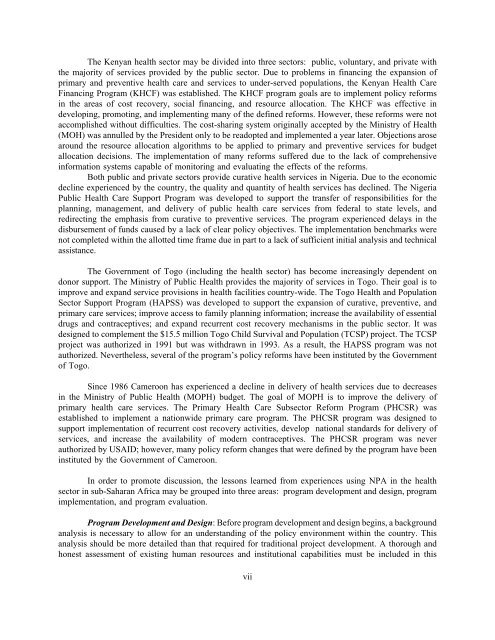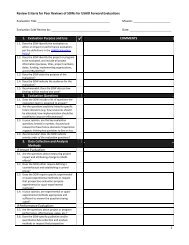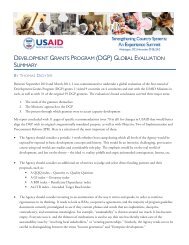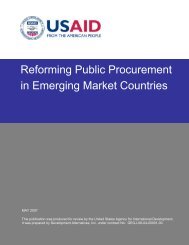Study on USAID Non-Project Assistance Programs in
Study on USAID Non-Project Assistance Programs in
Study on USAID Non-Project Assistance Programs in
Create successful ePaper yourself
Turn your PDF publications into a flip-book with our unique Google optimized e-Paper software.
The Kenyan health sector may be divided <strong>in</strong>to three sectors: public, voluntary, and private withthe majority of services provided by the public sector. Due to problems <strong>in</strong> f<strong>in</strong>anc<strong>in</strong>g the expansi<strong>on</strong> ofprimary and preventive health care and services to under-served populati<strong>on</strong>s, the Kenyan Health CareF<strong>in</strong>anc<strong>in</strong>g Program (KHCF) was established. The KHCF program goals are to implement policy reforms<strong>in</strong> the areas of cost recovery, social f<strong>in</strong>anc<strong>in</strong>g, and resource allocati<strong>on</strong>. The KHCF was effective <strong>in</strong>develop<strong>in</strong>g, promot<strong>in</strong>g, and implement<strong>in</strong>g many of the def<strong>in</strong>ed reforms. However, these reforms were notaccomplished without difficulties. The cost-shar<strong>in</strong>g system orig<strong>in</strong>ally accepted by the M<strong>in</strong>istry of Health(MOH) was annulled by the President <strong>on</strong>ly to be readopted and implemented a year later. Objecti<strong>on</strong>s arosearound the resource allocati<strong>on</strong> algorithms to be applied to primary and preventive services for budgetallocati<strong>on</strong> decisi<strong>on</strong>s. The implementati<strong>on</strong> of many reforms suffered due to the lack of comprehensive<strong>in</strong>formati<strong>on</strong> systems capable of m<strong>on</strong>itor<strong>in</strong>g and evaluat<strong>in</strong>g the effects of the reforms.Both public and private sectors provide curative health services <strong>in</strong> Nigeria. Due to the ec<strong>on</strong>omicdecl<strong>in</strong>e experienced by the country, the quality and quantity of health services has decl<strong>in</strong>ed. The NigeriaPublic Health Care Support Program was developed to support the transfer of resp<strong>on</strong>sibilities for theplann<strong>in</strong>g, management, and delivery of public health care services from federal to state levels, andredirect<strong>in</strong>g the emphasis from curative to preventive services. The program experienced delays <strong>in</strong> thedisbursement of funds caused by a lack of clear policy objectives. The implementati<strong>on</strong> benchmarks werenot completed with<strong>in</strong> the allotted time frame due <strong>in</strong> part to a lack of sufficient <strong>in</strong>itial analysis and technicalassistance.The Government of Togo (<strong>in</strong>clud<strong>in</strong>g the health sector) has become <strong>in</strong>creas<strong>in</strong>gly dependent <strong>on</strong>d<strong>on</strong>or support. The M<strong>in</strong>istry of Public Health provides the majority of services <strong>in</strong> Togo. Their goal is toimprove and expand service provisi<strong>on</strong>s <strong>in</strong> health facilities country-wide. The Togo Health and Populati<strong>on</strong>Sector Support Program (HAPSS) was developed to support the expansi<strong>on</strong> of curative, preventive, andprimary care services; improve access to family plann<strong>in</strong>g <strong>in</strong>formati<strong>on</strong>; <strong>in</strong>crease the availability of essentialdrugs and c<strong>on</strong>traceptives; and expand recurrent cost recovery mechanisms <strong>in</strong> the public sector. It wasdesigned to complement the $15.5 milli<strong>on</strong> Togo Child Survival and Populati<strong>on</strong> (TCSP) project. The TCSPproject was authorized <strong>in</strong> 1991 but was withdrawn <strong>in</strong> 1993. As a result, the HAPSS program was notauthorized. Nevertheless, several of the program’s policy reforms have been <strong>in</strong>stituted by the Governmentof Togo.S<strong>in</strong>ce 1986 Camero<strong>on</strong> has experienced a decl<strong>in</strong>e <strong>in</strong> delivery of health services due to decreases<strong>in</strong> the M<strong>in</strong>istry of Public Health (MOPH) budget. The goal of MOPH is to improve the delivery ofprimary health care services. The Primary Health Care Subsector Reform Program (PHCSR) wasestablished to implement a nati<strong>on</strong>wide primary care program. The PHCSR program was designed tosupport implementati<strong>on</strong> of recurrent cost recovery activities, develop nati<strong>on</strong>al standards for delivery ofservices, and <strong>in</strong>crease the availability of modern c<strong>on</strong>traceptives. The PHCSR program was neverauthorized by <strong>USAID</strong>; however, many policy reform changes that were def<strong>in</strong>ed by the program have been<strong>in</strong>stituted by the Government of Camero<strong>on</strong>.In order to promote discussi<strong>on</strong>, the less<strong>on</strong>s learned from experiences us<strong>in</strong>g NPA <strong>in</strong> the healthsector <strong>in</strong> sub-Saharan Africa may be grouped <strong>in</strong>to three areas: program development and design, programimplementati<strong>on</strong>, and program evaluati<strong>on</strong>.Program Development and Design: Before program development and design beg<strong>in</strong>s, a backgroundanalysis is necessary to allow for an understand<strong>in</strong>g of the policy envir<strong>on</strong>ment with<strong>in</strong> the country. Thisanalysis should be more detailed than that required for traditi<strong>on</strong>al project development. A thorough andh<strong>on</strong>est assessment of exist<strong>in</strong>g human resources and <strong>in</strong>stituti<strong>on</strong>al capabilities must be <strong>in</strong>cluded <strong>in</strong> thisvii







